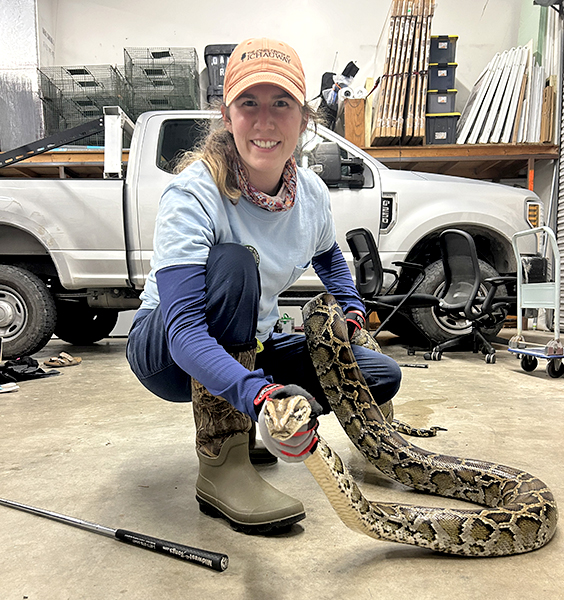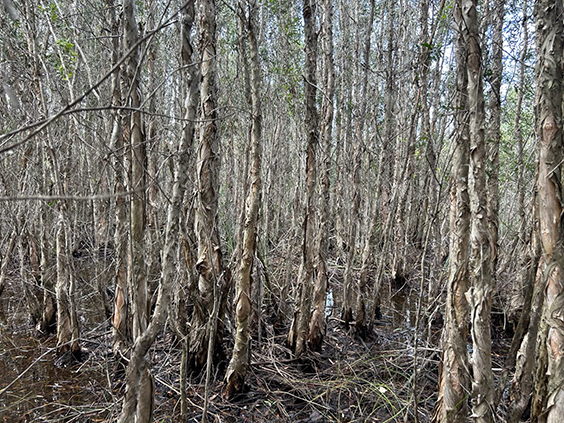Our People


Faith Kruis – Alumni Spotlight
Where are you now and what are you doing?
In November 2023, I became a Nonnative Fish and Wildlife Biologist with the Florida Fish & Wildlife Conservation Commission (FWC). My primary duties are to conduct surveys throughout southern Florida to find and remove nonnative constrictors such as Burmese pythons, Northern African pythons, boa constrictors, and rainbow boas. The surveys include Wildlife Management Areas, private land, lands managed by the South Florida Water Management District, among others. Surveys are done by either walking or driving. Driving surveys are typically on levees with vegetation and canals on either side of them. We partner with a university to test out their near-infrared (NIR) spectrum camera that gets mounted to our truck as another tool to find pythons. We do these surveys about 1-2 times a month when driving along levees. The walking survey-sites vary in vegetation composition, but the sites we visit most frequently are made up of sawgrass, melaleuca trees, Australian pine, and wiregrass.
This surprises many people, but I have yet to catch a nonnative snake from the “true” wild within the first few months of this job. Our “Ive-Got-One hotline” received a call recently of a Burmese python seen in a neighborhood, so I, along with a coworker, responded and removed it from the area. We spend most of our time looking for the less common nonnative snakes, or in areas that are not as densely populated. FWC has approximately 50 people contracted to remove Burmese pythons and they often catch several each month. I have participated in some “remote check-ins” with our FWC contractors when they catch pythons which involves a Teams call where I watch as they measure their snake. I record total length, weight, sex, and snout-vent length and input the measurements into our system.
I’ve also had the chance to help with a few necropsies, which we conduct occasionally on the captured nonnative snakes. During the necropsy we take samples of gut content, intestines, lungs, tail, and any abnormal findings that are then sent to FWC researchers and partnering labs at universities.
Some notable wildlife I’ve seen during fieldwork: an American crocodile, manatees, American alligators, a river otter, roseate spoonbills, bobcats, box turtles, cottonmouths, a striped mud turtle, and lots of herons, egrets, and wood storks.
What is one way your work is having a positive impact on natural resources and conservation?
Removing nonnative wildlife is important to protect our native wildlife species. Unfortunately, Florida is home to numerous nonnative wildlife species, reptiles in particular. Many of these nonnative species were part of the pet trade and have been released or escaped captivity. Florida’s warm climate and mild winters make it an especially accommodating environment to nonnative reptiles.
How did your time at Ichauway help prepare you for your current job or career?
What makes Ichauway special is the variety of people you meet when working there including technicians, scientists, visiting scientists, graduate students, and folks on the maintenance, administration, operation services, and conservation teams. Being surrounded by people with wide ranging backgrounds, expertise, and opinions shaped me into the biologist I am today. I took advantage of my time at Ichauway and helped with other’s fieldwork, such as checking insect emergence traps in wetlands, tracking radio-telemetered bobwhite quail, maintaining trail cameras for mesocarnivores, and taking measurements on amphiumas and sirens. Living amongst technicians and fellow graduate students allowed for conversations that opened my eyes to research practices and collection methods implemented in fields I was unfamiliar with, like landscape ecology, aquatic sciences, and entomology. These conversations broadened my view on the environment and ways in which research can be gathered within an ecosystem.
Public speaking and outreach were a large part of my graduate student career and continues to be a part of my current job. I was given the opportunity to present my research and other wildlife-related topics to classes that visited Ichauway at the 2023 Open House. Another important skill is being able to network with professionals. Ichauway helped me tremendously with this by inviting me to dinners with visiting scientists and the Woodruff Foundation.
What is one fond memory you have of your time at Ichauway?
I was at Ichauway for the summers of 2021 and 2022 and then from December 2022-November 2023. Although much of that time was spent working on my graduate research, I was still able to create lots of memories with friends that I made at Ichauway. Some memories include playing volleyball and cornhole, having group board-game nights, bonfires, potlucks, and going to the creek and river to swim. One feature that I love at Ichauway is the network of sandy roads that work as great walking trails. Several times a week, I would walk past the horses, through the Historic Circle, near the communal garden, and on some secondary roads to take in the beautiful nature and see wildlife like white-tailed deer, armadillos, turkey, and quail. The Ichauway community often came together for events like the Dog Days 5k, yard sale, and employee summer bash. I really enjoyed these opportunities to engage with other Ichauway folks that I didn’t cross paths with frequently in day-to-day work.
Faith Kruis – Alumni Spotlight

Where are you now and what are you doing?
In November 2023, I became a Nonnative Fish and Wildlife Biologist with the Florida Fish & Wildlife Conservation Commission (FWC). My primary duties are to conduct surveys throughout southern Florida to find and remove nonnative constrictors such as Burmese pythons, Northern African pythons, boa constrictors, and rainbow boas. The surveys include Wildlife Management Areas, private land, lands managed by the South Florida Water Management District, among others. Surveys are done by either walking or driving. Driving surveys are typically on levees with vegetation and canals on either side of them. We partner with a university to test out their near-infrared (NIR) spectrum camera that gets mounted to our truck as another tool to find pythons. We do these surveys about 1-2 times a month when driving along levees. The walking survey-sites vary in vegetation composition, but the sites we visit most frequently are made up of sawgrass, melaleuca trees, Australian pine, and wiregrass.
This surprises many people, but I have yet to catch a nonnative snake from the “true” wild within the first few months of this job. Our “Ive-Got-One hotline” received a call recently of a Burmese python seen in a neighborhood, so I, along with a coworker, responded and removed it from the area. We spend most of our time looking for the less common nonnative snakes, or in areas that are not as densely populated. FWC has approximately 50 people contracted to remove Burmese pythons and they often catch several each month. I have participated in some “remote check-ins” with our FWC contractors when they catch pythons which involves a Teams call where I watch as they measure their snake. I record total length, weight, sex, and snout-vent length and input the measurements into our system.
I’ve also had the chance to help with a few necropsies, which we conduct occasionally on the captured nonnative snakes. During the necropsy we take samples of gut content, intestines, lungs, tail, and any abnormal findings that are then sent to FWC researchers and partnering labs at universities.
Some notable wildlife I’ve seen during fieldwork: an American crocodile, manatees, American alligators, a river otter, roseate spoonbills, bobcats, box turtles, cottonmouths, a striped mud turtle, and lots of herons, egrets, and wood storks.
What is one way your work is having a positive impact on natural resources and conservation?
Removing nonnative wildlife is important to protect our native wildlife species. Unfortunately, Florida is home to numerous nonnative wildlife species, reptiles in particular. Many of these nonnative species were part of the pet trade and have been released or escaped captivity. Florida’s warm climate and mild winters make it an especially accommodating environment to nonnative reptiles.

How did your time at Ichauway help prepare you for your current job or career?
What makes Ichauway special is the variety of people you meet when working there including technicians, scientists, visiting scientists, graduate students, and folks on the maintenance, administration, operation services, and conservation teams. Being surrounded by people with wide ranging backgrounds, expertise, and opinions shaped me into the biologist I am today. I took advantage of my time at Ichauway and helped with other’s fieldwork, such as checking insect emergence traps in wetlands, tracking radio-telemetered bobwhite quail, maintaining trail cameras for mesocarnivores, and taking measurements on amphiumas and sirens. Living amongst technicians and fellow graduate students allowed for conversations that opened my eyes to research practices and collection methods implemented in fields I was unfamiliar with, like landscape ecology, aquatic sciences, and entomology. These conversations broadened my view on the environment and ways in which research can be gathered within an ecosystem.
Public speaking and outreach were a large part of my graduate student career and continues to be a part of my current job. I was given the opportunity to present my research and other wildlife-related topics to classes that visited Ichauway at the 2023 Open House. Another important skill is being able to network with professionals. Ichauway helped me tremendously with this by inviting me to dinners with visiting scientists and the Woodruff Foundation.
What is one fond memory you have of your time at Ichauway?
I was at Ichauway for the summers of 2021 and 2022 and then from December 2022-November 2023. Although much of that time was spent working on my graduate research, I was still able to create lots of memories with friends that I made at Ichauway. Some memories include playing volleyball and cornhole, having group board-game nights, bonfires, potlucks, and going to the creek and river to swim. One feature that I love at Ichauway is the network of sandy roads that work as great walking trails. Several times a week, I would walk past the horses, through the Historic Circle, near the communal garden, and on some secondary roads to take in the beautiful nature and see wildlife like white-tailed deer, armadillos, turkey, and quail. The Ichauway community often came together for events like the Dog Days 5k, yard sale, and employee summer bash. I really enjoyed these opportunities to engage with other Ichauway folks that I didn’t cross paths with frequently in day-to-day work.